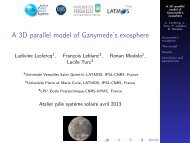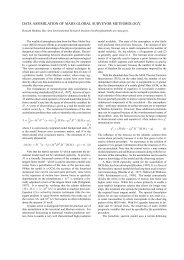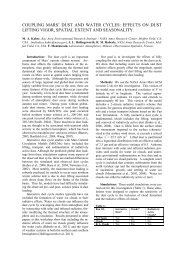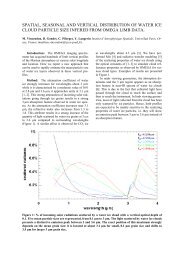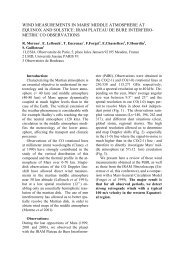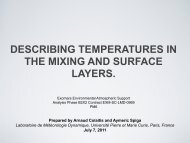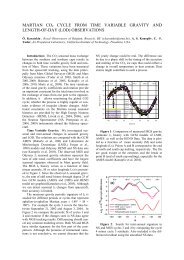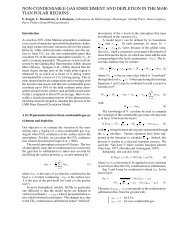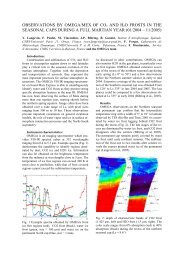MARS CLIMATE DATABASE v5.0 USER MANUAL - The Mars ...
MARS CLIMATE DATABASE v5.0 USER MANUAL - The Mars ...
MARS CLIMATE DATABASE v5.0 USER MANUAL - The Mars ...
Create successful ePaper yourself
Turn your PDF publications into a flip-book with our unique Google optimized e-Paper software.
Note for specialists: It has been made possible to keep a given large scale perturbation whilstonly changing the gravity wave small scale perturbation between calls. This is achieved by changingthe value of input argument gwlength between calls to call mcd. This feature, which should beusefull to people who might want to generate “realistic” longitude-height or latitude-height slicesover large horizontal distances (over which indeed gravity waves should not correlate), requiressome sensible choices in longitude/latitude spacing and gravity waves reseeding. It is meant forexperienced users and not advised for general use.5.5.2 Running timeIn order to minimize computational time, the datasets corresponding to encompassing months (ofsought input date) of a given MCD dust and EUV scenario are loaded from the database at the firstcall of the ’call mcd’ subroutine. This initial loading is time consuming, but once loaded thesevalues can then be used for further calls, as long as the sought dates do not lead to a change inbracketing months. This should be taken into account when simulating trajectories (or maps) overmore than a month; calls to call mcd should be ordered so that all data is gathered within each30 ◦ range of Ls (15 to 45, 45 to 75, ...).Similarly, only required data sets are loaded: if for instance no perturbations are requested, thenonly mean values are loaded. Note that requesting perturbations (perturkey set to 2,3 or 4), aswell as supplementary outputs (elements of extvarkeys set to 1), implies extra computationswhich will slow down the program.6 Calling the CALL MCD subroutine from IDL<strong>The</strong> Interactive Data Language (IDL) is a commercial software for data analysis and visualizationtool that is widely used in earth, planetary science and astronomy.<strong>The</strong> mcd/idl subdirectory contains two tools which show how the call mcd subroutine maybe called from IDL. Note that call mcd is not directly called from IDL as such, auxiliary Fortranprograms are used. <strong>The</strong>se programs are launched from the IDL session, and their output (written toan intermediate file) is then loaded and used.• mcd idl.pro is an IDL procedure that can be used to retrieve a block of atmospheric data fromthe <strong>Mars</strong> Climate database.– inputs: Solar longitude Ls (in degrees), Local time Loct (in martian hours), latitudelat (degrees north), east longitude lon (degrees),dust scenario dust (from 1 to 8),verticalcoordinate type zkey (1, 2, 3, or 4), high resolution mode hireskey (on:1, off:0) and verticalcoordinate xz (altitude, m or pressure level, Pa). All the time and space coordinatecan be IDL arrays. For instance, if you want to make a map of temperature at a givenlocal time, altitude, and Ls, then in input lat and lon should be arrays.– outputs: “meanvarz” and “extvarz” as defined for call mcd, except that they aremultidimensional arrays depending on the dimension of the inputs. For instance, inour example of a map, the IDL dimension of meanvarz will be DBLARR[5+1,nlat,nlon]5 . ”5+1” means here that contrary to the usual IDL convention meanvarz and extvarzleft index is only used starting at 1 to keep the same numbering than in the Fortran codeand thus follow the “call mcd subroutine outputs” given in section 5.4.– How to use it:1) Copy (you may also just use symbolic links) files constants mcd.inc, call mcdand heights.F from parent dircetory mcd/ to the current directory.2) Edit the the Fortran code mcd idl.F (which is used by IDL to call call mcd) and5 When multidimensinal data is sought, dimensions are arranged as follows: meanvarz[6,nlat,nlon,nz,nLs,nloctime]22



